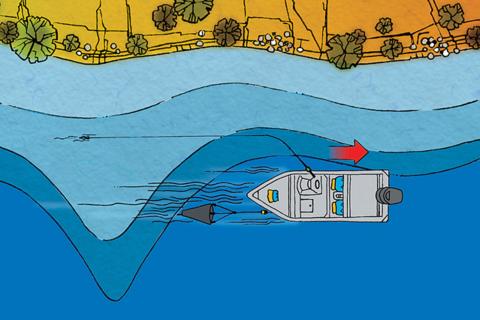
The Most Useful Item in Your Boat Could be a Drift Sock
- Daniel Quade with Jon Thelen
Coming home empty handed is frustrating, but it may not be your bait's fault. It may be your lack of boat control. It's a forgivable fishing sin. With all the attention on hidden honeyholes, hot lures and must-try tactics, it's easy to overlook the mundane matter of mastering your craft's speed and position. The truth is that all the killer lures, techniques and locations in the world won't save the day if you can't keep your boat from going too fast or drifting away from the strike zone. "Lure color, size and action are important, but depth and speed should be your first concerns," says veteran guide and tournament competitor Jon Thelen. "That means mastering boat control."
The most beneficial item you can have on hand when the winds blow the wrong way is a humble drift sock. "They're underutilized, but drift socks are the most efficient means of controlling boat speed and position," says Thelen. "Socks are versatile, too. They work in lakes and rivers, with a variety of presentations for walleye, sauger and other species of game fish. You can hang one off the boat when backtrolling, put one or two on the sides when drifting or run them off the back corner when forward trolling."
The concept is simple. By creating drag, a drift sock slows the boat and reduces bouncing in rough water, allowing you to tone down speed and smooth your presentation. By tying a sock at different points on the hull, you can tailor the boat's position in relation to key structure or the shoreline. Thelen says drift-sock applications are limited only by an angler's imagination. "When backtrolling, clip one to the eye where you tie your bowline," he says. "The lower point of attachment keeps it in the water better than clipping it to forward cleats, which tend to be high off the water. On a 20-ft. boat, I'd use a 48" drift sock at the front and a 60-incher at the stern.
This lets me make small course corrections with the trolling motor while keeping the boat sideways over the break." Bottom line is, a selection of three appropriately sized drift socks can help you tackle virtually any winds that are safe to fish. See the chart below for help selecting appropriate drift socks. Thelen also recommends using a drift-control harness buoy. "It keeps the harness from sagging down in the water, which creates slack in the rigging and can lead to surges in speed when wind or waves hit the boat. By keeping the harness near the surface, it greatly reduces your chances of snagging it when reeling in fish."
TIP:Use a drift-control harness buoy on your drift sock to keep it riding high in the water column to prevent snagging while reeling in a fish.
When backtrolling, clip a drift sock to the eye where you tie your bowline. The lower point of attachment keeps it in the water better than clipping it to forward cleats, which tend to be high off the water. The theory also transfers to side cleats that sit well above the waterline. On high-sided boats, add a 4-ft. section of rope to the rigging to maximize performance.
- 3421 views

